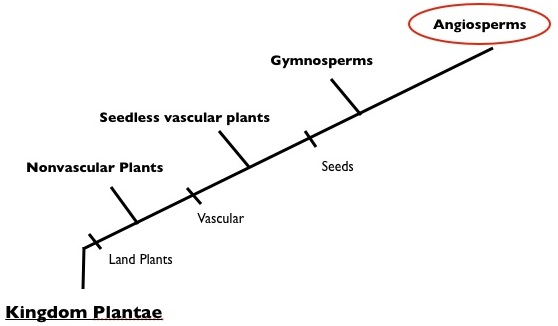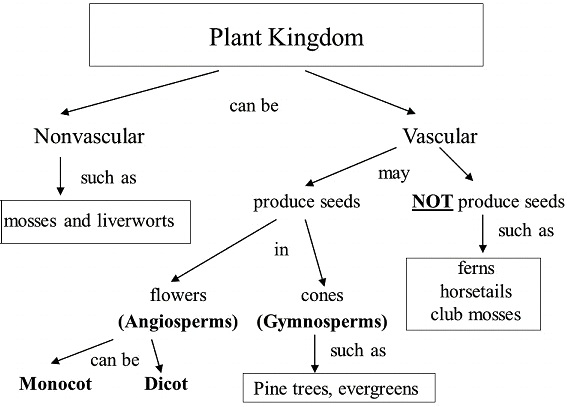Plant Kingdom
Table of Content |
 - There are millions of organisms like plants, animals, bacteria and viruses. Each one of these organisms is
- There are millions of organisms like plants, animals, bacteria and viruses. Each one of these organisms is  different from the other in one way or the other.
different from the other in one way or the other.
- About more than one million of species of animals and more than half a million species of plants have been studied.
- These species are described and provided names for identification.
- Thousands of species are still unknown and are yet to be identified and described. It is practically impossible to study each and every individual.
- Also, it is difficult to remember their names, characters and uses. However, biologists have devised various techniques for identification, naming and grouping of various organisms.
- The art of identifying organisms and placing them into groups that reflect their most significant features and relationship is called biological classification.
- Scientists who study and contribute to the classification of organisms are known as systematists or taxonomists, and their subject is called systematics (Gk. Systema = order of sequence) or taxonomy (Gk. Taxis = arrangement; nomos = law).
Watch this Video for more clarity on “Kingdom – Plantae”
History of Classification:
-
References of classification of organisms are available in Upanishads and Vedas.

-
About 740 plants and 250 animals are recorded in our Vedic literature.
-
Few other significant contributions in the field of classification are:
(1) Chandyogya Upanishad: In this, an attempt has been made to classify the animals.
(2) Susruta Samhita: It classifies all 'substances' into sthavara (immobile) e.g. plants and jangama (mobile) e.g. animals.
(3) Parasara: Here, angiosperms were classified into dvimatruka (dicots) and ekamatruka (monocots). He was even able to find that dicotyledons bear jalika parana (reticulate veined leaves) and monocotyledons bear maun laparna (parallel veined leaves).
(4) Hippocrates and Aristotle: They classified animals into four major groups like insects, birds, fishes and whales.
Topics Covered:
Type of System of Classification
Different systems of classification were proposed time to time. These have been divided into three basic categories viz., artificial systems, natural systems and phylogenetic system.
(1) Artificial system of classifications: These systems are more or less arbitrary as the plants are classified merely on the basis of gross morphology, habit and their importance to human beings. The main advocates of artificial system of classifications were:
(i) Theophrastus: He is known as the Father of botany. Theophrastus was a disciple of Plato and later Aristotle. In his book De Historia plantarum, he classified about 500 kinds of plants into four major group; trees, shrubs, sub shrubs and herbs.
(ii) Caius Plinius Secundus: He described the biological, medicinal and agricultural aspects of plants in 37 volumes of Natural History. He used the term 'Stamen' for the first time.
(iii) Pedanios Dioscorides: He described about 600 plants of medicinal importance in his Materia Medica.
(iv) Charaka: He was an Indian Scholar. He classified plants of medicinal importance in his Charaka Samhita.

(v) Andrea Caesalpino: He described 1520 species in 16 volumes of De Plantis libri grouped as herbs and trees. He further classified plants based on fruit and seed characters.
(vi) John Ray: He was a British botanist who published three volumes of his work Historia Generalish Plantarum consisting of improved classification originally proposed by him in Methodus Plantarum Noven. He was the first to divide the group’s herbs, shrubs and trees into Dicots and Monocots on the basis of the presence of two or one cotyledons respectively. He also coined the term species.
(vii) Carolus Linnaeus: He is known as the Father of taxonomy. He published an artificial system of classification based exclusively on floral characters. He also published several manuscripts including Hortus cliffortianus and Genera plantarum (1737). In his Genera plantarum, he listed all the plant genera known to him. He published his best known Species plantarum in 1753. In this book he listed and described all the species of plants known to him. He was the one to establish binomial nomenclature.

(2) Natural System of Classifications: These systems of classification are based not only on the characters of reproductive organs and structural morphology but used as many taxonomic characters or traits as possible to classify the plants. The advocates of natural systems of classification are listed below:
(i) Michel Adamson: A French botanist, who classified plants and animals using as many characters as possible and proposed a natural system of classification.
(ii) A.L. de Jussieu: He classified plants based on their natural characters. In his system of classification he grouped the plants resembling each other in a set of characters.
(iii) A.P. de Candolle: He grouped all alike plants together and published a new classification of plants in his book Theorie elementaire de la botanique (1813).
(iv) George Bentham and Joseph Dalton Hooker: These two English botanists classified plants based on original studies of specimens. They published their scheme of classification in Genera plantarum (1862–83). This system of classification is still regarded as the best classification, especially from the practical point of view.
-
Numerical Taxonomy: Numerical Taxonomy is based on the observable characteristics. Number and codes are assigned to all the characters and the data is then processed. Each character is given equal importance in this way and at the same time hundreds of characters can be considered.
-
Cytotaxonomy: Cytotaxonomy is the branch of taxonomy which is based on cytological information like chromosome number, structure, behaviour and chemotaxonomy.


Question1: Which one of the following is also algae
(1) Cyanobacteria
(2) Rhodospirillum
(3) Green bacteria
(4) Purple bacterium
Question2: Fungi are always –
(1) Autotrophs
(2) Heterotrophs
(3) Saprophytes
(4) Parasites
Question3: Yeast is an important source of –
(1) Vitamin C
(2) Vitamin B
(3) Vitamin A
(4) Vitamin D
Question4: Common form of food stored in a fungal cell is –
(1) Glycogen
(2) Starch
(3) Glucose
(4) Sucrose
Question5: Rhizopus belongs to the class –
(1) Ascomycetes
(2) Phyeomycetes
(3) Basidiomycetes
(4) Deuteromycetes


| Q.1 | Q.2 | Q.3 | Q.4 | Q.5 |
| 1 | 2 | 2 | 1 | 2 |
To read more, Buy study materials of Plant Kingdom comprising study notes, revision notes, video lectures, previous year solved questions etc. Also browse for more study materials on Biology here.
View courses by askIITians


Design classes One-on-One in your own way with Top IITians/Medical Professionals
Click Here Know More

Complete Self Study Package designed by Industry Leading Experts
Click Here Know More

Live 1-1 coding classes to unleash the Creator in your Child
Click Here Know More

a Complete All-in-One Study package Fully Loaded inside a Tablet!
Click Here Know MoreAsk a Doubt
Get your questions answered by the expert for free